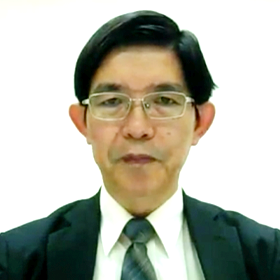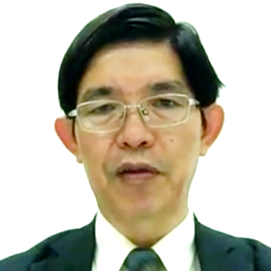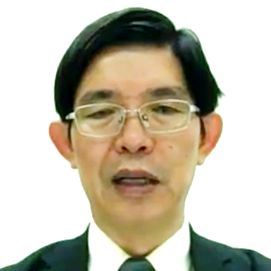Key person interview

Expectations for the development of new treatments
Hematology and Oncology Professor
Mr. Ritsuro Suzuki
About TREAKISYM
Question 1. First, I would like to ask about your specialty, Dr. Suzuki.
He specializes in lymphoid malignancies, especially malignant lymphomas, especially NK/T-cell lymphomas.
Question 2. Could you tell us the significance of TREAKISYM being able to be used for patients with new-onset FL (follicular lymphoma)?
TREAKISYM is a highly effective drug for malignant lymphoma, and it is a drug that always comes up as an option at the time of recurrence. It makes treatment much easier. Of course, not all FL patients will use it from the first onset, but I think it is very important that it has become an option for patients who want to use it from the first onset, or for those who are concerned about the side effects of other drugs.
In addition, one of the characteristics of TREAKISYM is that if there is a period of time after the previous treatment, a certain degree of efficacy can be expected even if retreatment is performed. It is meant to be expanded. Of course, it is highly effective, but it can be said that it is an easy-to-use drug because adverse events and side effects are mild compared to other antitumor anticancer drugs.
Question 3. From 2021, TREAKISYM will be available for DLBCL (diffuse large B-cell lymphoma). What do you think is the significance of this?
Compared to follicular lymphoma and other low-grade lymphomas, DLBCL progresses more rapidly, making it difficult to treat without highly effective drugs. Therefore, of course, TREAKISYM alone is effective, but I believe that the greatest role TREAKISYM has played in the treatment of DLBCL is that it can be expected to be even more effective when used in combination with other drugs.
Question 4. Could you give us your frank opinions and impressions of SymBio Pharmaceuticals' efforts?
SymBio Pharmaceuticals is not a large company compared to major Japanese pharmaceutical companies, but it has TREAKISYM, a drug with potential for the future. TREAKISYM is expected to be effective in the treatment of malignant lymphoma, and I believe that in this area in particular, the information provision activities are on a par with those of major companies. Drugs such as TREAKISYM cannot be sold once they are made, and it is extremely important to provide information on proper use, such as drug usage and side effect management. By actively providing information on proper use, SymBio Pharmaceuticals has gained the trust of doctors who treat malignant lymphoma, and I believe that opportunities for its use in treatment are increasing.

About EB virus
Question 5. What kind of virus is EB virus (Epstein-Barr virus)?
EB virus is a very common virus. More than 90% of Japanese adults are infected with this virus. When first infected, flu-like symptoms such as fever and sore throat appear. After infection, a mechanism that eliminates the EB virus acts to suppress its activity, but it continues to exist in the body for a long time in the form of persistent infection. Normally, even if it remains in the body after the first infection with EB virus, it is a virus that does not cause much harm. However, it is said that it can be one of the oncogenic viruses for a small number of people.
The incidence of EB virus-associated lymphoma is not very high. For example, NK-cell lymphoma associated with EB virus is a very rare tumor that accounts for only about 3% of all lymphomas. The number of people who actually develop malignant lymphoma, especially NK/T-cell lymphoma, is probably one in hundreds of thousands, which is very low, but it is very characteristic that this virus is involved in tumorigenesis. It's a virus.
Question 6. Does that mean that most people do not need any special treatment even if they are infected with the EB virus?

I agree. No treatment is needed for most people. However, the symptoms of EB virus infection are cold-like symptoms caused by an immune response to the virus, but some people have very strong symptoms. Even in such cases, rest or symptomatic treatment such as antipyretics and anti-inflammatory analgesics is often the only treatment. Therefore, treatment of the infection itself is often not necessary.
Question 7. Could you tell us a little more about the relationship between the EB virus and the development of lymphoid tumors?
There are two types of EB virus-associated lymphoid tumors. One is called immunodeficiency-associated lymphoproliferative disease. The EB virus usually does not cause any adverse effects even if it is latent in the body. However, when immunosuppressive drugs are used after hematopoietic stem cell transplantation or solid organ transplantation such as kidney or liver transplantation, the immune system, mainly the lymphatic system, that suppresses EB virus is suppressed, and EB virus reactivates. A phenomenon called reactivation phenomenon in which it proliferates in the body may occur. Lymphoproliferative disease is a condition in which lymphocytes proliferate as the EB virus proliferates, and the number of virus-infected lymphocytes increases. The initial stage is not necessarily malignant, but if left untreated, the lymphocytes containing the EB virus will proliferate more and more like a tumor. This leads to an increase in monoclonality, that is, cells derived from one cell. This condition is similar to a tumor. In other words, lymphoproliferative disease is simply a state of lymphocyte proliferation in the early stages, but in the later stages it becomes a condition similar to malignant lymphomas, especially DLBCL, which usually develop. In that case, treatment with anticancer drugs may be necessary, and if treatment is ineffective, it may take human lives. This is called a lymphoproliferative disorder.
Another type of lymphoid tumor is some EB virus-positive lymphomas. One is called NK/T-cell lymphoma, and it may be said that more than 90%, almost 100% of lymphoma cells are infected with EB virus, but it is also infected with EB virus. Unlike lymphoproliferative disorders, these lymphocytes appear in the form of tumors from the beginning.
In addition to this NK/T-cell lymphoma, there are also types called EBV-positive DLBCL, and some T-cell lymphomas that are positive for the EB virus. It is speculated that the proliferative power of the EB virus is one of the reasons why lymphocytes become tumors even in this type of lymphoma. Currently, the presence or absence of the EB virus does not make a difference in the treatment policy, but if drugs that can suppress the EB virus appear, there is a possibility that the treatment related to these will change in the future.
About NK/T-cell lymphoma
Question 8. Could you tell me again what kind of disease NK/T-cell lymphoma is?
There are three main types of lymphocytes: B cells, T cells, and NK cells. Among them, T cells and NK cells are closely related.
NK/T-cell lymphoma is a disease characterized mainly by an increase in NK cells. The reason is unknown, but it is known that EB virus is involved in many cases. Another feature is that it appears very often around the nose in the human body. Therefore, the frequency of NK-cell lymphoma is high in lymphoma originating from the nasal area, and in other organs, NK-cell lymphoma is common in lymphoma that arises from sites other than lymph nodes, such as the skin and the gastrointestinal tract. It is speculated that it has an affinity for extranodal organs, but the reason is currently unknown.
NK-cell lymphoma is a relatively rare disease type, accounting for only about 3% of all lymphomas. The major difference between NK/T cell lymphoma and other types of lymphoma is that normal NK cells excrete foreign substances as part of lymphocyte detoxification, and anticancer drugs are also excreted outside the cells. It has a pump called P-glycoprotein. On the other hand, tumorigenic NK-cell lymphoma also has the characteristic that some anticancer drugs are excreted outside the cells, making anticancer drugs less effective. Therefore, in the era when NK-cell lymphoma was treated in the same way as lymphoma of other cells, some anticancer drugs were ineffective and lymphoma was said to be a poor prognosis lymphoma that was difficult to cure.
Furthermore, for unknown reasons, it is known that Caucasians in Europe and the United States are less likely to develop NK/T-cell lymphoma than Japanese. Therefore, from Europe and the United States, there is almost no new data on NK cell lymphoma from basic research to clinical research. As a result, it is necessary to conduct joint research not only in Japan but also in neighboring countries such as South Korea and China.・Confirmation of response to treatment has been performed. Since there is almost no information from Europe and the United States, it is the current situation that we Asians have to do something about it.
Question 9. NK/T-cell lymphoma has a very low incidence, but what are the patterns that many patients come to see at the hematology department?
Patterns vary depending on the primary organ. Earlier, I mentioned that most cases start from the nose, but in the type that starts from the nose, there are initial symptoms such as runny nose, nosebleeds, and stuffy nose, but they do not improve, so I consulted an otolaryngologist. I am often introduced to a hematology department through a department teacher.
The next most common organ is the skin. There are cases in which a dermatologist introduces a rash with a change in color on the skin that does not heal easily.
In addition, if this lymphoma appears throughout the body, symptoms such as fever or bleeding tendency that does not stop bleeding may be observed. Since NK/T-cell lymphoma is rare, it is not often found directly at university hospitals, and is often referred through doctors at nearby clinics. Therefore, I mentioned earlier that it develops from various organs other than lymph nodes, but the symptoms vary depending on the organ where the disease develops.
Question 10. What are the current main treatments for NK/T-cell lymphoma?
Currently, treatment of NK/T-cell lymphoma varies greatly depending on whether the lymphoma is limited (localized stage) or systemic (advanced stage). I said that the nose is the most common initial organ, but radiation therapy works well around the nose or in a limited area, so this is performed. However, it has been found that radiotherapy alone causes recurrence to some extent, so concurrent therapy with radiation and anticancer drugs is often performed. This treatment was developed in Japan.
On the other hand, in the case of advanced stage lymphoma, radiotherapy cannot be applied to the whole body, so treatment with anticancer drugs is selected. At this time, it is common to perform "SMILE therapy" by combining drugs that are not affected by the P-glycoprotein that excretes the anticancer drug mentioned earlier from the cell. This treatment is completely different from other types of lymphoma and was jointly developed by Japan, South Korea, and China.
In the advanced stage, it is difficult to completely cure with anticancer drug treatment alone, so autologous transplantation (using one's own hematopoietic stem cells) or allogeneic transplantation (blood production from another person) is performed after anticancer drug treatment. It has been found that stem cell-based transplantation should be followed by initial SMILE therapy.
Question 11. Please tell us about the challenges in treating NK/T-cell lymphoma.
NK/T-cell lymphoma used to be a very incurable lymphoma, but new types of treatment that are different from other lymphomas have been developed, and the treatment results have improved considerably. However, not everyone will be cured. First of all, it is said that lymphoma is in the limited stage, and even those who can receive radiotherapy because the spread of lymphoma is limited are not 100% cured. About 50% of people who undergo stem cell transplantation will relapse, so there is a need to develop new treatments for such people.
Expectations for SymBio Pharmaceuticals
Question 12. Please tell us about the topics and areas that you are currently interested in, Professor Suzuki.
In lymphoma, although it is not limited to NK/T-cell lymphoma, many drugs called molecular-targeted drugs are appearing for other lymphomas as well. This is a drug that works by a mechanism different from that of conventional anticancer drugs and exhibits an antitumor effect. These new drugs are not only highly effective, but also often exhibit effects through mechanisms different from those of conventional drugs. It can have unexpected effects such as 3 instead of 2. Therefore, I am very interested in considering the possibility of combining new drugs in the future.
Question 13. What are your expectations for SymBio Pharmaceuticals in the future?
There are two main expectations for SymBio Pharmaceuticals. One is about the anti-cancer drug TREAKISYM. TREAKISYM is effective against many types of lymphoma, but currently, insurance approval has been obtained in Japan for low-grade lymphoma such as follicular lymphoma, mantle cell lymphoma, and diffuse large cell lymphoma. Only for B-cell lymphoma, not indicated for T-cell lymphoma, NK-cell lymphoma, Hodgkin's lymphoma, etc. However, there are overseas reports that it is effective, so we believe that it may be possible to treat with TREAKISYM alone. In the future, I would like to expect the application to be expanded. Furthermore, there have been reports of several treatments that are even more effective when combined with the molecular-targeted drug I was talking about earlier and TREAKISYM. Since this type of treatment is currently not available in Japan, we expect new indications to be expanded. Another thing I'm looking forward to is an antiviral drug called brincidofovir. Since brincidofovir SymBio Japan, we have high expectations for its development. The disease for which this drug is expected to have a direct effect is the complication of adenoviral hemorrhagic cystitis. This is a type of cystitis in which adenovirus infects the bladder mucosa and causes bleeding, mainly in some patients who underwent hematopoietic stem cell transplantation. Currently, there are no effective antiviral drugs, so patients endure only symptomatic treatment until they get better. , which is very painful for the patient. In some cases, cystitis spreads to pneumonia, which is life-threatening. I think that if brincidofovir which is expected to suppress this adenovirus, becomes available in Japan, it will be a very big deal. Masu. Another possibility is that brincidofovir has been found to suppress the growth of the EB virus, which has been named earlier, in vitro. Although there is little need to use antiviral drugs against EB virus infection itself, many tumors associated with EB virus and recurrent NK/T cell lymphoma are difficult to cure. By combining this with existing anticancer drugs or molecularly targeted drugs, it may be possible to further enhance the efficacy of conventional anticancer drugs. However, regarding this point, whether or not it is really effective cannot be known until it is administered to patients, so it is necessary to go through clinical trials. If such a thing becomes possible, it could be a great blessing for people who currently have no treatment, such as relapsed NK/T-cell lymphoma, so we are pursuing this possibility. I would be happy if you could.
